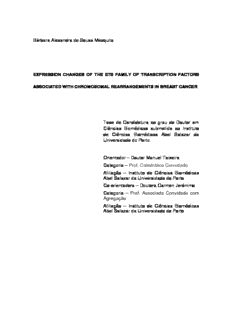
Bárbara Alexandra de Sousa Mesquita Tese de Candidatura ao grau de Doutor em Ciências ... PDF
Preview Bárbara Alexandra de Sousa Mesquita Tese de Candidatura ao grau de Doutor em Ciências ...
Bárbara Alexandra de Sousa Mesquita EXPRESSION CHANGES OF THE ETS FAMILY OF TRANSCRIPTION FACTORS ASSOCIATED WITH CHROMOSOMAL REARRANGEMENTS IN BREAST CANCER Tese de Candidatura ao grau de Doutor em Ciências Biomédicas submetida ao Instituto de Ciências Biomédicas Abel Salazar da Universidade do Porto. Orientador – Doutor Manuel Teixeira Categoria – Prof. Catedrático Convidado Afiliação – Instituto de Ciências Biomédicas Abel Salazar da Universidade do Porto Co-orientadora – Doutora Carmen Jerónimo Categoria – Prof. Associada Convidada com Agregação Afiliação – Instituto de Ciências Biomédicas Abel Salazar da Universidade do Porto This PhD thesis includes data published in the following article Mesquita B, Lopes P, Rodrigues A, Pereira D, Afonso M, Leal C, Henrique R, Lind GE, Jerónimo C, Lothe RA, Teixeira MR. (2013). Frequent copy number gains at 1q21 and 1q32 are associated with overexpression of the ETS transcription factors ETV3 and ELF3 in breast cancer irrespective of molecular subtypes. Breast Cancer Res Treat. 138(1): 37-45. Epub 2013 Jan 18. (Appendix). ACKNOWLEDGMENTS I am grateful to the following people/entities: First I would like to thank my principal supervisor, Professor Manuel Teixeira, who conducted and supported me in this project. Then to my co-supervisor, Professor Carmen Jerónimo, for the continuous support, encouragement and solicitude. To Professor Ragnhild Lothe, who kindly received me in her laboratory, my profound thanks. My warmest thanks to the Department of Pathology of the Portuguese Oncology Institute – Porto, namely to Professor Rui Henrique, Drª Paula Lopes, Drª Mariana Afonso and Drª Conceição Leal, who always were available to extra work, to clarify my doubts and specially for their continued interest and support. The most kindly thanks to the Department of Oncology of the Portuguese Oncology Institute – Porto, namely to Drª Deolinda Pereira and Drª Ana Rodrigues, who were indefatigable and always available. I also would like to thank to the Fundação para a Ciência e Tecnologia and to the Instituto de Ciências Biomédicas Abel Salazar – Universidade do Porto. My gratefulness to all the past and current members of Department of Genetics of the Portuguese Oncology Institute – Porto. And obviously I must thank the unconditional support of my family. TABLE OF CONTENTS ACKNOWLEDGMENTS ................................................................................................................5 TABLE OF CONTENTS .................................................................................................................7 FIGURES AND TABLES INDEX .................................................................................................. 11 ABBREVIATIONS ....................................................................................................................... 17 ABSTRACT ................................................................................................................................. 25 RESUMO ..................................................................................................................................... 29 INTRODUCTION ......................................................................................................................... 33 1. BREAST DISEASES............................................................................................................ 33 1.1. BREAST TISSUE AND ASSOCIATED PATHOLOGIES ................................................................ 33 1.2. BREAST CANCER ............................................................................................................. 34 1.2.1. RISK AND PROTECTIVE FACTORS ............................................................................................... 34 1.2.2. DIAGNOSIS ............................................................................................................................ 36 1.2.3. BREAST CANCER CLASSIFICATION ............................................................................................. 42 1.2.3.1. Breast cancer histological classification ......................................................................... 42 1.2.3.2. Breast cancer grading ................................................................................................... 43 1.2.4. MOLECULAR SUBTYPES .......................................................................................................... 44 1.3. BREAST CANCER TREATMENT ........................................................................................... 46 2. PATHWAYS TO BREAST CANCER .................................................................................... 47 2.1. STEP BY STEP TOWARDS BREAST CANCER ......................................................................... 48 2.2. MOLECULAR BASIS OF BREAST CANCER ............................................................................. 51 2.2.1. ONCOGENES AND TUMOR SUPPRESSOR GENES ............................................................................ 51 2.2.2. EPIGENETIC ALTERATIONS ....................................................................................................... 52 2.2.3. ANEUPLOIDY AND CHROMOSOMAL ALTERATIONS ......................................................................... 52 2.2.4. ETS GENES ........................................................................................................................... 53 AIMS ........................................................................................................................................... 59 MATERIAL AND METHODS ....................................................................................................... 63 1. PATIENTS AND TUMOR SPECIMENS ................................................................................ 63 2. IMMUNOHISTOCHEMICAL CHARACTERIZATION ............................................................ 63 3. ERBB2 GENE CHARACTERIZATION ................................................................................. 65 4. COMPARATIVE GENOMIC HYBRIDIZATION ..................................................................... 66 5. COPY NUMBER EVALUATION OF THE ETV3, ELF3 AND ELK4 GENES .......................... 67 6. GENE EXPRESSION ........................................................................................................... 68 7. STATISTICAL ANALYSIS ................................................................................................... 70 RESULTS .................................................................................................................................... 73 1. ERBB2 STATUS AND IMMUNOHISTOCHEMISTRY ........................................................... 73 2. OVERALL PATTERN OF GENOMIC CHANGES BY CGH .................................................. 80 3. 1q ETS COPY NUMBER GAINS BY FISH ........................................................................... 81 4. ETS GENE EXPRESSION ................................................................................................... 82 5. EXPRESSION OF POTENTIAL ETS TARGET GENES ....................................................... 83 6. CLINICO-PATHOLOGICAL CORRELATIONS .................................................................... 83 DISCUSSION .............................................................................................................................. 87 1. 1q COPY NUMBER CHANGES AND 1q ETS EXPRESSION .............................................. 87 2. THE ROLE OF ELF3 IN BREAST CARCINOGENESIS ....................................................... 87 3. THE ROLE OF ETV3 IN BREAST CARCINOGENESIS ....................................................... 89 4. THE ROLE OF ELK4 IN BREAST CARCINOGENESIS ....................................................... 91 5. MYC AS A TARGET GENE OF 1q ETS TRANSCRIPTION FACTORS ................................ 91 6. CRISP3 AS A TARGET GENE OF 1q ETS TRANSCRIPTION FACTORS ........................... 92 7. CLINICO-PATHOLOGICAL ASSOCIATIONS ...................................................................... 93 CONCLUSION ......................................................................................................................... 94 FUTURE STUDIES .................................................................................................................. 94 BIBLIOGRAPHY ......................................................................................................................... 97 APPENDIX…………………………………………………………………………………………………113 Figures and Tables Index FIGURES AND TABLES INDEX Figures and Tables Index
Description: